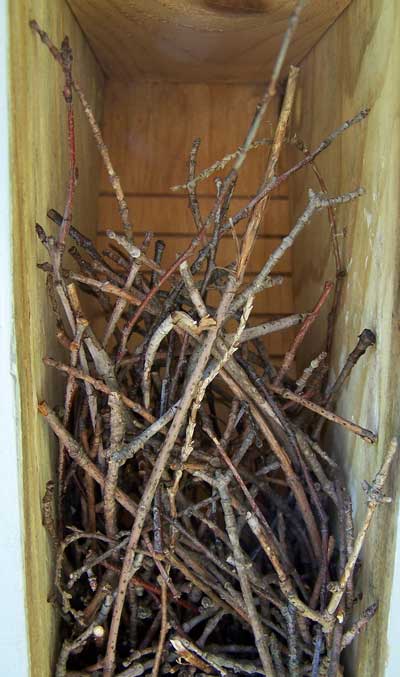
Birds often check out several locations before deciding on which one they will use to raise a family. Sometimes a nest is started or even completed, but A House Wren dummy nest. Note loose construction, no nest cup, does not fill box completely. Photo by Bet Zimmerman Smith.
not used. This can be disappointing for the monitor who was looking for some real action in that box. Here are probable reasons:
- Dummy Nests: A dummy nest is an eggless nest not used for breeding, usually built by the male. House Wren males build true “dummy” nests in a number of cavities within their territory. These nests are usually loosely constructed, and lack an egg cup lined with fur/hair/grass/feathers. These may be to offer the female some choices. She chooses the cavity she wants to use, and then reconstructs the nest in that location. Sticks in other boxes are left in place, possibly to prevent other competitors from nesting nearby. (As this does decrease the likelihood that those boxes will be used by another species, I remove dummy nests. See more on deterring House Wrens.) Carolina Wren and Prothonotary Warbler males may build dummy nests.
- Indecision: Carolina Chickadee pairs sometimes start excavating and nest building at several sites before choosing one for egg laying.
- Paired boxes: When two boxes are near each other, sometimes a Tree Swallow or Bluebird will build a partial or complete nest in the neighboring box. This may be because they can’t decide which box to use (see indecision), or it may be to deter other birds from nesting in the second box. Sometimes the second nest is used for a second brood.
- Problems and Predators : Sometimes a nest is started and then abandoned because of a problem. Maybe paperwasps have moved in, fire ants showed up, or a predator spooked them. (I had a Tufted Titmouse abandon nest building when I opened a box while she was inside adding material.) Maybe one of the pair is lost. House Sparrow or Tree Swallow harassment may drive them off. A squirrel might take the box over. Sometimes eggs are removed/destroyed or eaten (e.g., by House Wrens, Squirrels, etc.) before you even knew egg laying had begun. If unhatched existing eggs do not hatch after incubation, the female may lay a new clutch or move. Many birds will move to a different location after an unsuccessful nesting attempt.
If you are unsure whether the nest of a native bird is active or not, DO NOT REMOVE it. See more info on cleaning out nestboxes.
MORE ON HOUSE WREN DUMMY NESTS
I am guessing House Wrens build dummy nests primarily to:
1) signal possession of territory. Unlike many other species of small cavity nesters, male House Wrens typically arrive before females. Perhaps staking claims also gives them something to do while awaiting the arrival of females.
2) make cavities less appealing or unavailable to competitors. Many small cavity nesters like bluebirds have not evolved to remove existing nesting material like House Wrens do. Chickadees may remove wood chips, but I have not heard of them removing sticks. I am also guessing that some competitors are capable of recognizing even a few sticks as a sign they will probably lose eggs or nestlings to aggressively territorial House Wrens.
3) to make nest sites more appealing to female partners. At least for humans, a staged home tends to sell faster than a vacant one.
4) to expedite nest building. Once the female House Wren chooses a nest site, she removes existing dummy nest sticks, and rebuilds a nest to her specifications. The male has thus expedited her nest building by supplying some needed construction materials.
Benjamin E. Leese (Bluebird Journal, Summer 2018, p.14 and 15) hypothesized that dummy nests may also:
- demonstrate male fitness
- distract or wear out or act as a decoy to predators
- offer defense against ectoparasites like blow flies, and brood parasites like cowbirds
- deter egg dumping by other females.
More information:
- Widows and Widowers
- Monitoring
- Deterring House Wrens
- Pairing
- Cleaning out nestboxes
- Predator and Problem ID and Solutions
- unhatched eggs.htm”>Why didn’t the egg hatch?
– Keanna Leonard, Rowe Sanctuary, Kearney, NE
